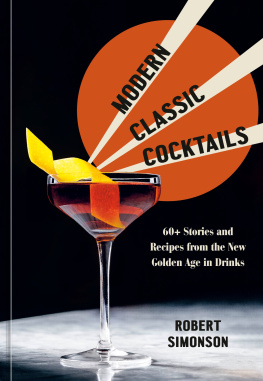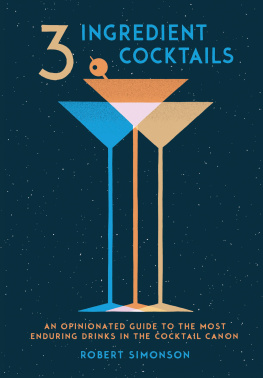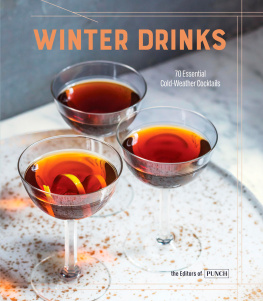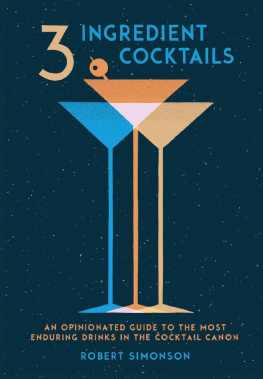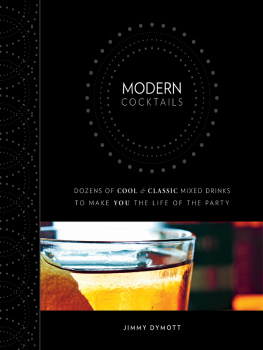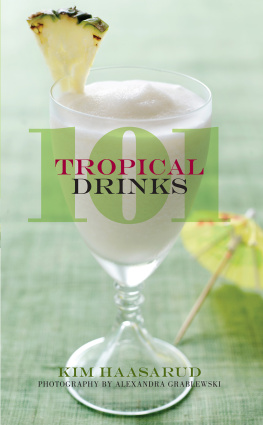Ravi DeRossi - Cuban Cocktails : 100 Classic and Modern Drinks
Here you can read online Ravi DeRossi - Cuban Cocktails : 100 Classic and Modern Drinks full text of the book (entire story) in english for free. Download pdf and epub, get meaning, cover and reviews about this ebook. year: 2019, genre: Home and family. Description of the work, (preface) as well as reviews are available. Best literature library LitArk.com created for fans of good reading and offers a wide selection of genres:
Romance novel
Science fiction
Adventure
Detective
Science
History
Home and family
Prose
Art
Politics
Computer
Non-fiction
Religion
Business
Children
Humor
Choose a favorite category and find really read worthwhile books. Enjoy immersion in the world of imagination, feel the emotions of the characters or learn something new for yourself, make an fascinating discovery.
- Book:Cuban Cocktails : 100 Classic and Modern Drinks
- Author:
- Genre:
- Year:2019
- Rating:5 / 5
- Favourites:Add to favourites
- Your mark:
- 100
- 1
- 2
- 3
- 4
- 5
Cuban Cocktails : 100 Classic and Modern Drinks: summary, description and annotation
We offer to read an annotation, description, summary or preface (depends on what the author of the book "Cuban Cocktails : 100 Classic and Modern Drinks" wrote himself). If you haven't found the necessary information about the book — write in the comments, we will try to find it.
Cuban Cocktails : 100 Classic and Modern Drinks — read online for free the complete book (whole text) full work
Below is the text of the book, divided by pages. System saving the place of the last page read, allows you to conveniently read the book "Cuban Cocktails : 100 Classic and Modern Drinks" online for free, without having to search again every time where you left off. Put a bookmark, and you can go to the page where you finished reading at any time.
Font size:
Interval:
Bookmark:


CUBAN
COCKTAILS
CLASSIC & MODERN DRINKS
RAVI DEROSSI, JANE DANGER & ALLA LAPUSHCHIK
PHOTOGRAPHY BY GABI PORTER


STERLING EPICURE is a trademark of Sterling Publishing Co., Inc.
The distinctive Sterling logo is a registered trademark of
Sterling Publishing Co., Inc.
2015 by DeRossi Global LLC
Design by Lorie Pagnozzi
All rights reserved. No part of this publication may be reproduced,
stored in a retrieval system, or transmitted in any form or by any
means (including electronic, mechanical, photocopying, recording, or
otherwise) without prior written permission from the publisher.
ISBN 978-1-4549-3617-6
For information about custom editions, special sales, and premium and
corporate purchases, please contact Sterling Special Sales at
800-805-5489 or .
www.sterlingpublishing.com
Some of the recipes in this book contain raw eggs. Consuming raw or undercooked eggs may increase your risk of food-borne illness. The young, elderly, pregnant women, and anyone who may be immunocompromised should not consume them.
BIENVENIDOS
A CIENFUEGOS,
BIENVENIDOS
A CUBA!


W. C. Fields
CIENFUEGOS IS MANY THINGS: a hundred fires, a province, a breezy port city, a governor, a battle, a revolutionary, and a tropical gathering place in the pulsing heart of Manhattans East Village.
Cienfuegos, Cubaon the southern coast, facing the Cayman Islandswas founded on April 22, 1819, as Fernandina de Jagua by French emigrants led by Louis de Clouet and named in honor of the Spanish king, Fernando VII. When the settlement became a town a decade later, the king authorized changing its name to Cienfuegos to honor Jos Cienfuegos y Jovellanos, captain general of the island. As the nineteenth century progressed, Cienfuegos became a vital port city, strategic for sugarcane and tobacco production. In sun-drenched streets bathed in tropical breezes, men ordered their rums by the finger, and women sipped exotic punches.
At the end of the 1800s, Cuba tried desperately to throw off the chains of centuries of Spanish rule. The three-year Cuban War of Independence began in 1895, and its final three months transformed what had been a regional struggle for freedom into an international conflict, pulling the United States into the hostilities and sparking the Spanish-American War. Two weeks after the start of that war, three American ships set out to sever key undersea telegraph cables connecting the island and others in the region. In the Battle of Cienfuegos, which took place on May 11, 1898, the American ships destroyed the cable house and cut two of the three targeted lines before escaping from advancing Spanish forces.
Half a century later, Cuba was chafing under the military dictatorship of Fulgencio Batista y Zaldvar. A scrappy young student named Camilo Cienfuegos y Gorriarn, harried by officials for his antigovernment politics, left the country and, after a stay in New York, headed to Mexico. There he met Fidel Castro Ruz, who was plotting to overthrow Batista. In November 1956, Cienfuegos joined Castro and eighty other revolutionaries aboard the Granma, which sailed from Tuxpan, Mexico, to Playa Las Coloradas, near Niquero. Cienfuegos and only a dozen or so of the others survived Batistas counterattack, but the invaders rallied, and Cienfuegos soon became one of the revolutions strategic leaders, rising to the rank of comandante. Batista fled Cuba on January 1, 1959, yielding power to Castros forces. But Cienfuegoss prominence didnt last. In October of that year, his plane disappeared over the ocean, never to be found.
Cuba today represents a distillation of its incredible history. Its a mixing pot, influenced for both good and bad by the cycle of occupation and the struggle for independence. Today the waters of Cienfuegos Bay lap at the citys shores. Groves of mangoes line its outskirts. Horse-drawn carriages remain a respectable form of transportation. Time moves slowly, and history clings to the spectacular architecture. Each afternoon, the park at the tip of the city, called La Punta, fills with families and friends. People cool themselves in the waters off the rocky coastline or sit leisurely around a bottle of Havana Club.
Rum, to the people of Cuba, is the spirit of fire. When we opened Cienfuegos in 2006, we wanted to capture some of that mysterious Cuban essence in a bright, cheerful, welcoming refuge from the harsh frenzy of New York City. On the corner of 6th Street and Avenue A in the East Village, tucked away on the second floor, youll find Cienfuegos, the bar inspired by the spirit of Cuba. In this intimate space of faded pinks, greens, and yellows, the plaster cracks as if in some old house in Cuba. Each night, we light one hundred candles, one hundred fires, to embrace the past and present of rum culture and the community it inspires. Cienfuegos stands as an altar to the spirit of fire and our homage to Cuba. It has brought three of our greatest passions together here for you: hospitality, writing, and of course drinking. Our cocktails have a strong foundation in the classics, which we update into our modern interpretations. You will find both in the pages of this book.
We cant gather around a bottle of Havana Club yet, but we can capture that sense of community by gathering around the punch bowl, which predates the modern cocktail and represents centuries of history mixed together, transforming over time as palates and environments changed. After all, gathering around the punch bowl is a tradition as old as rum itself, and it played a part in another, earlier revolution in the Americas. Bostons Museum of Fine Arts houses the punch bowl that Paul Revere made to honor the Glorious 92, Massachusetts legislators who refused to obey the British Crown. Punch also made and unmade legendary pirates, including Bartholomew Roberts, the most successful raider of the golden age of piracy.
Unlike in America, Cuban cocktail culture never dissolved into a dark age of convenience aimed at easier, faster, sweeter intoxication. Prohibition, that thirteen-year failed experiment, inversely fortified cocktail culture in Cuba, creating its own golden age. Even today, Cuban cocktail menus prominently feature classics that barely see the light of day on menus stateside. Bartenders there have been organized as a group since 1924. At Caf Madrigal, the bartender showed us his copy of the cocktail manual, which features 1,100 recipes, each footnoted with the history of the drink.
Trader Vic, a leading founder of the tiki style of cocktails, found that same respect when he visited the island in the 1930s. The skill and grace of the bartenders amazed him, and their knowledge inspired him (and, later, us). Bartenders accommodated customers palates without sacrificing the integrity of the drinksexactly what we try to do in New York City, gently guiding unwary customers away from Tequila Sunrises or Long Island Iced Teas while still giving them something they will enjoy.
Font size:
Interval:
Bookmark:
Similar books «Cuban Cocktails : 100 Classic and Modern Drinks»
Look at similar books to Cuban Cocktails : 100 Classic and Modern Drinks. We have selected literature similar in name and meaning in the hope of providing readers with more options to find new, interesting, not yet read works.
Discussion, reviews of the book Cuban Cocktails : 100 Classic and Modern Drinks and just readers' own opinions. Leave your comments, write what you think about the work, its meaning or the main characters. Specify what exactly you liked and what you didn't like, and why you think so.


